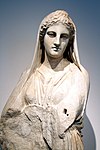Equestrian statue of Frederick William IV
1886 establishments in Germany1886 sculpturesAC with 0 elementsEquestrian statues in GermanyGermany sculpture stubs ... and 4 more
Outdoor sculptures in BerlinSculptures of men in GermanyStatues in BerlinStatues of monarchs

The equestrian statue of Frederick William IV is an 1875–86 sculpture of Frederick William IV of Prussia by Alexander Calandrelli, installed in front of the Alte Nationalgalerie in Berlin, Germany.
Excerpt from the Wikipedia article Equestrian statue of Frederick William IV (License: CC BY-SA 3.0, Authors, Images).Equestrian statue of Frederick William IV
Platz der Märzrevolution, Berlin Mitte
Geographical coordinates (GPS) Address Website Nearby Places Show on map
Geographical coordinates (GPS)
| Latitude | Longitude |
|---|---|
| N 52.5206 ° | E 13.3986 ° |
Address
Museumsinsel
Platz der Märzrevolution
10117 Berlin, Mitte
Germany
Open on Google Maps









